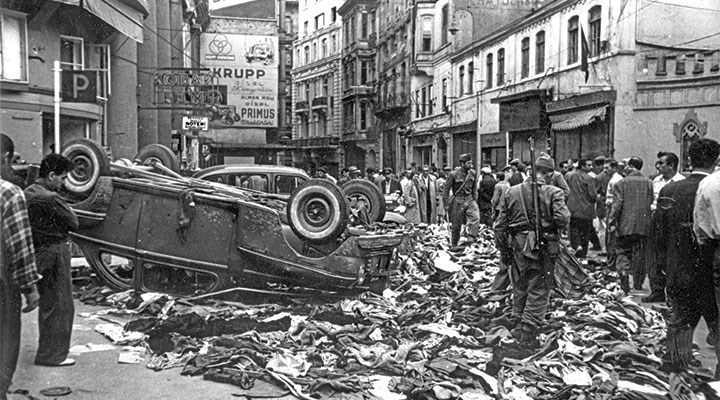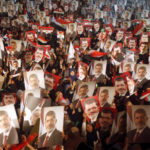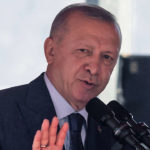The İstanbul pogrom started on the evening of Sept. 6, 1955, when mobs took to the streets of İstanbul and raided the Greek, Armenian and Jewish districts, destroying or looting non-Muslim houses of worship, homes, businesses, cemeteries and schools.
“I was 14 years old. I remember that night, hearing the sound of looting while we were trying to listen to the news on the radio. My father went to the window and said they were attacking the grocery store owned by Garo, our Armenian neighbor. Then a rock broke our window,” said Konstantinos Papadopoulos, who moved to Athens with his family immediately after the September 6-7 pogrom.
Turkish Minute also spoke with Orhan Kemal Cengiz, a lawyer and human rights defender who thinks the September 6-7 pogrom was one of the biggest state-planned provocations and that it was an important turning point in Turkish history.
“When you look carefully at the mobs, you see that the political problems we face in Turkey today started in those days. As the head of the Special Warfare Department [ÖHD] would admit years later, September 6-7 was a ‘wonderful operation,’ one of the horrendous examples of the disgraceful incidents that the state and the people carried out together in this country,” says Cengiz.
Gen. Sabri Yirmibeşoğlu, a Turkish Army officer at the time of the pogrom, said in an interview in 1991 that September 6-7 had been the work of the army’s ÖHD.
“It was an excellent ÖHD operation. It achieved its goal. I’m asking you: Wasn’t it an excellent operation?” he asked the journalist who was interviewing him.
The pogrom was triggered by false and orchestrated news reports in the Turkish press which insinuated that Greeks had set off a bomb the day before at the Turkish consulate in the northern Greek city of Thessaloniki, where the founder of modern Turkey, Mustafa Kemal Atatürk, had been born.
Supporting the views of the ruling Democrat Party, the İstanbul Express newspaper ran the headline “Our father Atatürk’s house has been bombed.”
Some 290,000 issues were printed on September 6, exceeding by far the usual circulation of 20,000. Members of the pro-government Cypriot Turkish Association started to distribute the paper all over İstanbul to agitate the people.
“My father was saying that the Turkish media had been promoting hatred of the Greeks for a long time, well before the pogrom. But who were those Greeks, according to the Turks? For some, they were the ones in Greece or Cyprus, but for others, they were the Greeks in İstanbul. Turkey was our home, we lived in İstanbul and were not responsible for the politics of the situation. All of a sudden we were all accused of the bombing,” Papadopoulos said during an interview with Turkish Minute.
According to Cengiz, there are always people in Turkey ready to provoke others and attack “traitors” for the sake of the country and the “good of the nation.”
“Do you know how many people participated in the looting of houses and workplaces on September 6-7? Most people think the number is 300 to 500 or maybe a thousand or two, right? Wrong. The participants were not in the thousands or tens of thousands, but the hundreds of thousands. And most importantly, when we look at photos of the pogrom, we can see people from different socioeconomic backgrounds.
Armenians and Jews in İstanbul shared the same fate as the Greeks — their homes and shops were destroyed. Churches and cemeteries were attacked as well; icons, crucifixes and other sacred objects were destroyed, and churches in İstanbul were set on fire. In fact, the target was not only the Greeks, it was all non-Muslim minorities. Since they were all seen as enemies, they were treated accordingly.
According to official data, the extensive damage and cost to minorities — Greeks, Armenians and Jews — included 4,214 homes, 1,004 businesses, 73 churches, two monasteries, one synagogue and 26 schools.
Estimates of the economic cost of the damage vary between $24.8 million (Turkish government) to $500 million (Greek government).
According to the Ecumenical Patriarchate of Constantinople, some 200 Greek women were raped. It was also reported that Greek boys were raped and that a priest was burned alive. Many Greek men, including at least one priest, were subjected to forced circumcision.
“That night and the nationalist attacks are just history for young people and scholars, but for me, they’re a memory, a life experience. As a witness, I can say it was the first day of my family’s long tragedy,” says Papadopoulos.
The Papadopoulos family, like thousands of non-Muslims in Istanbul, was not yet aware at the beginning of the September 6-7 events that their own state was intending to destroy their property, businesses and houses of worship to force them to abandon their homeland.
“My father and uncles had shops in the Beyoğlu district of central İstanbul — they were totally destroyed that night. It took many years for my family to recover financially as well as psychologically… İstanbul was our home, and when we moved to Athens we really missed our life in İstanbul,” he adds.
The homes and workplaces of Greeks and other non-Muslim communities had been identified by the mobs beforehand. A day before the pogrom, the attackers had told the owners of Turkish shops to “put Turkish flags in their windows” as a sign of their “Turkishness.”
The pogrom started a wave of migration out of Turkey; however, the Turkish press covered it as “the customary disloyalty of minorities.” Within a few months, the biggest businesses had been transferred from non-Muslims to Muslims, and the businesses that were destroyed were never reopened.
Most of the Greeks who stayed were exiled to Greece in 1964 — another tragedy in Turkey’s history. In that year some 30,000 Greeks in Turkey were forced to leave their birthplace with personal belongings weighing no more than 20 kilograms and no more than $20. They were not allowed to sell their houses or property or to withdraw money from their bank accounts before they left.
Sixty-six years after the pogrom that devastated Turkey’s non-Muslim community, Turkey’s minorities continue to live a difficult life. There are still occasional attacks on churches and cemeteries.
İstanbul’s Greek minority, which comprised some 100,000 before the pogrom, is currently estimated to number less than 2,000, which means, as Gen. Yirmibeşoğlu stated, “The operation achieved its goal.”
To the question of whether Turkish officials have ever paid any moral or material reparations for the 1955 pogrom or shown any sign of remorse or grief years after it, Cengiz’s answer is a short “Sadly, no.”
According to Cengiz, there are many skeletons in the closet of all political movements that have tasted power in Turkey.
“Every political movement in Turkey thinks that its own sins of the past belong to its political rivals. In fact, from the right to the left, all political parties in Turkey have a lot of dirty laundry. Adnan Menderes, the prime minister of the time, was undoubtedly one of the politicians responsible for the September 6-7 pogrom. But there was a larger, deep state-related group with different actors in charge of this pogrom, and still today, they are not judged. Impunity is an ‘old disease’ in Turkey,” he says.
By: Alin Ozinian
Source:Turkish Minute
***Show us some LOVE by sharing it!***



